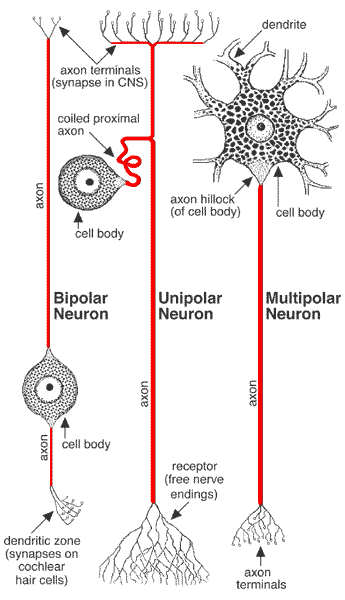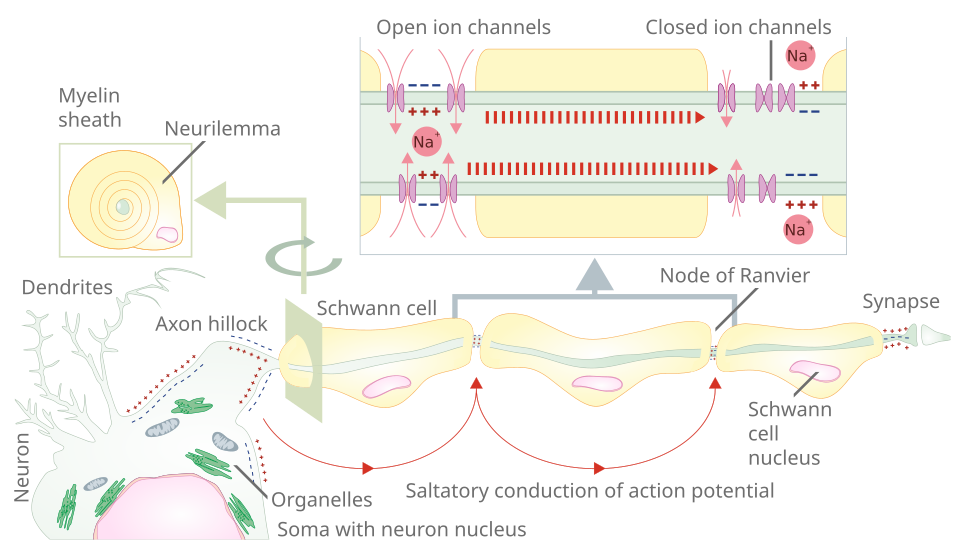OCR Specification focus:
‘Compare structure and functions of sensory, relay and motor neurones, including differences between myelinated and non-myelinated fibres.’
These notes compare neurone classes and their wiring, then explain how myelination changes impulse transmission, clarifying nervous system organisation and the speed–accuracy trade-offs in signalling.
Neurone types: structure and function
Neurone: An excitable cell specialised to receive, process and transmit information by electrical impulses and chemical synapses.
In the human nervous system three canonical classes—sensory, relay, and motor neurones—have architectures tailored to their roles in information flow.

Labeled drawing of unipolar (pseudounipolar), bipolar, and multipolar neurones used to represent sensory, relay, and motor functions respectively. The schematic emphasises how the number and arrangement of processes (dendrites/axon) relate to information flow. This figure matches the level of detail required for OCR and avoids extraneous pathway labelling. Source.
Sensory neurones (afferent)
Function: Carry impulses from receptors (e.g. mechanoreceptors, photoreceptors) into the central nervous system (CNS).
Structure: Commonly pseudo-unipolar in mammals: a single process splits into a long dendron bringing signals from the receptor towards the cell body and a short axon passing into the CNS. The cell body lies in the dorsal root ganglion just outside the spinal cord.
Special senses: Some are bipolar (one dendrite, one axon), as in the retina and olfactory epithelium.
Design logic: Long input limb minimises synapses between the sense organ and CNS, preserving signal fidelity.
Relay neurones (interneurones)
Function: Integrate and route information within the CNS, linking sensory input to motor output and forming local circuits for processing.
Structure: Typically multipolar with many short, highly branched dendrites and short axons; cell bodies reside in grey matter of brain or spinal cord.
Design logic: Short processes, numerous synapses and high convergence/divergence support computation, inhibition, and pattern recognition across networks.
Motor neurones (efferent)
Function: Carry impulses from the CNS to effectors (skeletal muscle, smooth muscle, glands) to produce a response.
Structure: Multipolar; large soma in the ventral horn of the spinal cord or motor cranial nuclei; many dendrites receive synaptic input; a single long axon projects to the target.
Neuromuscular junction: The axon terminal forms a specialised synapse with muscle fibres for precise activation of contraction.
Design logic: A long, fast-conducting output limb allows timely, coordinated movement.
Myelination: structure, mechanism and consequences
Myelination: The wrapping of axons by Schwann cells (PNS) or oligodendrocytes (CNS) to form a multilayered myelin sheath that electrically insulates the membrane.
In the peripheral nervous system, a Schwann cell spirals repeatedly around a single axon, extruding cytoplasm to create compact myelin; in the CNS, one oligodendrocyte myelinates segments of multiple axons. Between myelinated segments lie nodes of Ranvier, short uninsulated gaps rich in voltage-gated ion channels.
Saltatory conduction: Impulse propagation in myelinated fibres where depolarisation “jumps” node-to-node, boosting speed and conserving energy.
Because myelin greatly increases membrane resistance and decreases capacitance, current flows rapidly along the insulated internode to the next node, where the action potential is regenerated.

Diagram of saltatory conduction along a myelinated peripheral axon, highlighting Schwann cell internodes and nodes of Ranvier where voltage-gated channels cluster. Red arrows depict the apparent “jumping” of depolarisation from node to node, explaining faster, energy-efficient transmission. The layout aligns with OCR expectations and omits advanced molecular detail. Source.
Myelinated versus non-myelinated fibres
Architecture
Myelinated fibres: Thick multilamellar sheath; nodes of Ranvier at 1–3 mm intervals; one axon per Schwann cell wrap (PNS).
Non-myelinated fibres: Axons lie in a Schwann cell groove with no concentric wrapping; several small axons share a single Schwann cell; membrane remains largely exposed.
Conduction mode
Myelinated: Saltatory conduction; depolarisation confined to nodes; rapid local currents traverse internodes.
Non-myelinated: Continuous conduction; depolarisation must be regenerated along the entire length, making propagation slower.
Speed and diameter
Myelinated: Typically fast (≈30–120 m s⁻¹ in large fibres); speed scales with axon diameter and internode length.
Non-myelinated: Slow (≈0.5–2 m s⁻¹); diameter has a smaller effect because there is no insulating sheath.
Energy economy
Myelinated: Fewer ion exchanges overall; reduced Na⁺/K⁺ pump workload between spikes; improved efficiency during high-frequency activity.
Non-myelinated: More membrane area depolarised per impulse; higher metabolic cost per unit distance.
Functional deployment
Rapid, precise signalling (e.g. motor commands, discriminative touch, proprioception) uses large, myelinated axons for minimal delay.
Background or modulatory signalling (e.g. slow pain, temperature, autonomic regulation) commonly uses thin, non-myelinated fibres where speed is less critical.
Relating neurone type to myelination
Motor neurones: Their long axons to skeletal muscle are heavily myelinated, ensuring swift, synchronised activation of motor units across limbs and trunk.
Sensory neurones: Touch and proprioceptive afferents are myelinated for high-fidelity timing; many nociceptors and thermoreceptors are non-myelinated, producing slower, lingering sensations that still convey protective information.
Relay neurones: Often unmyelinated or thinly myelinated with short processes; computation depends more on synaptic networks than on long-distance conduction speed.
Comparing structures at a glance (as required by OCR)
Sensory neurone: Pseudo-unipolar; receptor → long dendron → cell body (dorsal root ganglion) → short axon → CNS; function—conveys environmental or internal stimuli to the CNS.
Relay neurone: Multipolar; cell body entirely within CNS, many short dendrites and short axon; function—links pathways, enabling integration and decision-making.
Motor neurone: Multipolar; cell body in spinal cord/brainstem, many dendrites, long axon to effector; function—drives responses in muscles or glands.
Myelinated vs non-myelinated fibres:Saltatory versus continuous conduction; faster and more energy-efficient versus slower and energetically costlier; structural insulation present versus absent.
FAQ
Myelination depends on the function, axon diameter, and the type of pathway the neurone serves.
Large-diameter axons are usually myelinated to allow rapid, long-distance transmission (e.g. motor neurones).
Thin axons often remain non-myelinated, where speed is less critical (e.g. pain and temperature pathways).
Developmentally, Schwann cells or oligodendrocytes initiate myelination by wrapping around axons, guided by cell-surface proteins and growth factors.
Nodes of Ranvier must be close enough for depolarising current to reach the next node without fading. The spacing (typically 1–3 mm) balances speed and signal reliability.
Too far apart: the current weakens before triggering the next action potential.
Too close: the advantage of insulation is reduced.
This regular spacing ensures efficient saltatory conduction while maintaining consistent transmission along the axon.
A larger axon diameter reduces internal electrical resistance, allowing ionic current to flow more easily along the cytoplasm.
In myelinated fibres, both diameter and myelin thickness contribute to very fast transmission.
In non-myelinated fibres, increasing diameter still improves speed but not as dramatically, since depolarisation must occur along the entire length.
This principle explains why vertebrates rely on myelin rather than giant axons to achieve high conduction speeds.
Damage to myelin, such as in multiple sclerosis, disrupts saltatory conduction.
Action potentials slow or fail to propagate between nodes.
Exposed membrane leads to ion leakage and random depolarisations.
Motor, sensory, or coordination deficits result, depending on which fibres are affected.
Loss of myelin also increases energy demand on neurones because more of the membrane must be repolarised.
Both form myelin but differ in location and structure:
Schwann cells operate in the peripheral nervous system, myelinating one axon segment each. They also assist with nerve regeneration after injury.
Oligodendrocytes reside in the central nervous system and extend processes to multiple axons simultaneously, but they cannot promote regeneration effectively.
These distinctions reflect adaptations to the differing repair and connectivity requirements of peripheral versus central neural tissue.
Practice Questions
Question 1 (2 marks)
Explain one structural difference between a sensory neurone and a motor neurone, and relate this difference to their function.
Mark scheme:
• 1 mark for identifying a correct structural difference (e.g. sensory neurone is pseudo-unipolar / motor neurone is multipolar).
• 1 mark for linking structure to function (e.g. sensory neurone has a long dendron to carry impulses from receptors towards the cell body, whereas motor neurone’s long axon carries impulses from CNS to effectors).
Question 2 (5 marks)
Describe how myelination affects the transmission of nerve impulses and explain why myelinated fibres transmit impulses faster than non-myelinated fibres.
Mark scheme:
• 1 mark for stating that myelin acts as an electrical insulator preventing ion movement across the membrane.
• 1 mark for stating that action potentials occur only at the nodes of Ranvier.
• 1 mark for describing that impulses appear to ‘jump’ from node to node — saltatory conduction.
• 1 mark for explaining that this reduces the number of depolarisations along the axon, speeding up conduction.
• 1 mark for noting that fewer ions cross the membrane overall, reducing the use of ATP by the sodium-potassium pump and increasing energy efficiency.

